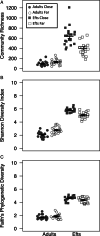Life stage and proximity to roads shape the skin microbiota of eastern newts (Notophthalmus viridescens)
- PMID: 35355399
- PMCID: PMC9790580
- DOI: 10.1111/1462-2920.15986
Life stage and proximity to roads shape the skin microbiota of eastern newts (Notophthalmus viridescens)
Abstract
Host-associated microbiomes play an essential role in the health of organisms, including immune system activation, metabolism and energy uptake. It is well established that microbial communities differ depending on the life stage and natural history of the organism. However, the effects of life stage and natural history on microbial communities may also be influenced by human activities. We investigated the effects of amphibian life stage (terrestrial eft vs. aquatic adult) and proximity to roadways on newt skin bacterial communities. We found that the eft and adult life stages differed in bacterial community composition; however, the effects of roads on community composition were more evident in the terrestrial eft stage compared to the aquatic adult stage. Terrestrial efts sampled close to roads possessed richer communities than those living further away from the influence of roads. When accounting for amplicon sequence variants with predicted antifungal capabilities, in the adult life stage, we observed a decrease in anti-fungal bacteria with distance to roads. In contrast, in the eft stage, we found an increase in anti-fungal bacteria with distance to roads. Our results highlight the need to consider the effects of human activities when evaluating how host-associated microbiomes differ across life stages of wildlife.
© 2022 The Authors. Environmental Microbiology published by Society for Applied Microbiology and John Wiley & Sons Ltd.
Figures




Similar articles
-
Changes in the gut microbial community of the eastern newt (Notophthalmus viridescens) across its three distinct life stages.FEMS Microbiol Ecol. 2021 Mar 8;97(3):fiab021. doi: 10.1093/femsec/fiab021. FEMS Microbiol Ecol. 2021. PMID: 33547890
-
Temporal changes in cutaneous bacterial communities of terrestrial- and aquatic-phase newts (Amphibia).Environ Microbiol. 2017 Aug;19(8):3025-3038. doi: 10.1111/1462-2920.13762. Epub 2017 Jun 6. Environ Microbiol. 2017. PMID: 28419728
-
Amphibian skin microbiota exhibits temporal variation in community structure but stability of predicted Bd-inhibitory function.ISME J. 2017 Jul;11(7):1521-1534. doi: 10.1038/ismej.2017.41. Epub 2017 Apr 7. ISME J. 2017. PMID: 28387770 Free PMC article.
-
Occurrence of 11-oxotetrodotoxin in the red-spotted newt, Notophthalmus viridescens, and further studies on the levels of tetrodotoxin and its analogues in the newt's efts.Toxicon. 2003 Jun;41(7):893-7. doi: 10.1016/s0041-0101(03)00068-0. Toxicon. 2003. PMID: 12782090
-
Dissecting skin microbiota and microenvironment for the development of therapeutic strategies.Curr Opin Microbiol. 2023 Aug;74:102311. doi: 10.1016/j.mib.2023.102311. Epub 2023 Apr 4. Curr Opin Microbiol. 2023. PMID: 37019058 Review.
Cited by
-
Ontogeny drives shifts in skin bacterial communities in facultatively paedomorphic salamanders.Microbiology (Reading). 2023 Oct;169(10):001399. doi: 10.1099/mic.0.001399. Microbiology (Reading). 2023. PMID: 37815535 Free PMC article.
References
-
- Barnes, E.M. , Kutos, S. , Naghshineh, N. , Mesko, M. , You, W. , and Lewis, J.D. (2021) Assembly of the amphibian microbiome is influenced by the effects of land‐use change on environmental reservoirs. Environ Microbiol 28: 4595–4611. - PubMed
-
- Bataille, A. , Lee‐Cruz, L. , Tripathi, B. , and Waldman, B. (2018) Skin bacterial community reorganization following metamorphosis of the fire‐bellied toad (Bombina orientalis). Microb Ecol 75: 505–514. - PubMed
Publication types
MeSH terms
Substances
LinkOut - more resources
Full Text Sources

